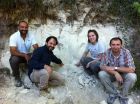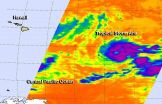Study identifies risk factors for sexual assault, including age and alcohol consumption
2014-10-15
(Press-News.org) Risk factors for sexual assault, including young age and alcohol consumption, must be addressed when considering preventative strategies, suggests a new study, published today (15 October) in BJOG: An International Journal of Obstetrics and Gynaecology (BJOG).
The Danish study used data from all women attending the specialised centre for victims of sexual assault (CVSA) in Copenhagen for sexual assault or attempted sexual assault between March 2001 and December 2010. A total of 2541 women were included in the sample.
The study aimed to describe the victims of sexual assault and the circumstances in which the assaults occurred in order to identify risk factors and enable the development of preventative measures. A focus was placed on how age and the relationship between the victim and the perpetrator were associated with the circumstance of the assault.
Over the last decade, it has been increasingly recognised that many patients seen in the healthcare system have a history of sexual assault and in 2002 the World Health Organisation classified sexual violence as a major public health problem and underlined the need for further research in this field.
Results of this study showed that 66% of the women were aged 15-24 years old and 75% had met the perpetrator before the sexual assault with nearly 50% reporting that the perpetrator was a current or former boyfriend, family member or someone they considered a friend.
Women with no previous contact or knowledge of their perpetrator were more likely to report to the police and were at a higher risk of sustaining an injury, the research showed.
Looking specifically at alcohol, the study found that over 40% of women had consumed more than 5 units of alcohol. These women were more often sexually assaulted by a stranger or someone they met within 24 hours prior to the assault.
Furthermore, a physical injury was found in 53% of cases and 33% of the victims had suffered a previous sexual assault.
Dr Mie-Louise Larsen, from the Centre for Victims of Sexual Assault Department and the University of Copenhagen and co-author of the study said:
"Our results challenge the typical stereotype of a violent rape attack by a stranger, which is important in creating an environment where women are not reluctant to seek help after a sexual assault.
"We need to raise awareness of the fact that most sexual assaults are perpetrated by someone known to the woman, often in familiar surroundings. Many victims will not sustain a physical or anogenital injury. In order to change the general attitudes towards sexual assault, this information should not only target young people, but also the police, healthcare professionals and the general public."
Patrick Chien, BJOG deputy editor-in-chief said:
"Identifying risk factors for sexual assault is vital for both the prevention of assaults and the improvement of early interventions.
"The results of this study suggest young age and drinking alcohol were risk factors for sexual assault. The study provides us with further insight and explores the circumstances in which sexual assaults occur, which women are vulnerable in which settings and identifies the most important contributory factors to help with the development of measures to prevent sexual assault."
INFORMATION:
ELSE PRESS RELEASES FROM THIS DATE:
2014-10-15
It seems logical that a student who is interested in science as an academic subject would also know a lot about science, but new findings show that this link depends on the overall wealth of the country that the teen calls home. The research suggests that individual science achievement may be influenced as much by broad national-level resources as it is by personal interest and motivation.
This is a photo of students in a chemistry class."Our results suggest that children with high levels of interest in science are able to turn their scientific interest into actual science ...
2014-10-15
A new study, published online in the journal Age and Ageing today, shows that the homebound status of adults over the age of 65 in the aftermath of the 2011 Great East Japan Earthquake is still a serious public health concern. Of 2,327 older adults surveyed, approximately 20% were found to be homebound.
A team of researchers led by Naoki Kondo of the University of Tokyo's School of Public Health studied data from the city of Rikuzentakata, an area that was seriously damaged by the disaster. Of its total population of 23,302 before the events of 2011, 1,773 people died ...
2014-10-14
New Rochelle, October 14, 2014 –Big Data analytics are helping to provide answers to many complex problems in science and society, but they have not contributed to a better understanding climate science, despite an abundance of climate data. When it comes to analyzing the climate system, Big Data methods alone are not enough and sound scientific theory must guide data modeling techniques and results interpretation, according to an insightful article in Big Data, the highly innovative, peer-reviewed journal from Mary Ann Liebert, Inc., publishers. The article is available ...
2014-10-14
ATHENS, Ohio (Oct. 14, 2014)—It's been millions of years since T. rex took its last breath, but a team led by Ohio University scientists is breathing life back into dinosaurs using high-powered computer simulations to model airflow through dinosaur snouts. The research has important implications for how dinosaurs used their noses to not only breathe but to enhance the sense of smell and cool their brains.
"Dinosaurs were pretty 'nosy' animals," said Ohio University doctoral student Jason Bourke, lead author of the new study published today in the Anatomical Record. ...
2014-10-14
In 2012, the "Mars One" project, led by a Dutch nonprofit, announced plans to establish the first human colony on the Red Planet by 2025. The mission would initially send four astronauts on a one-way trip to Mars, where they would spend the rest of their lives building the first permanent human settlement.
It's a bold vision — particularly since Mars One claims that the entire mission can be built upon technologies that already exist. As its website states, establishing humans on Mars would be "the next giant leap for mankind."
But engineers at MIT say the project ...
2014-10-14
This week, an international team of researchers, led by the Chinese Academy of Agricultural Sciences in Beijing, published in the journal Nature Genetics a brief genomic history of tomato breeding, based on sequencing of 360 varieties of the tomato plant.
The C.M. Rick Tomato Genetics Resource Center at UC Davis played an important role in this study by providing seed of both cultivated tomato varieties and related wild species.
This study, which builds on the first tomato genome sequence completed just two years ago, shows in great detail how the processes of early ...
2014-10-14
Researchers at Ludwig-Maximilians-Universitaet (LMU) in Munich have chemically modified an anti-diabetic agent so as to make its action dependent on light. The resulting prototype compound, termed JB253, induces release of insulin only when pancreas cells are exposed to blue light.
Synthetic, light-sensitive, molecular switches can be utilized to control biochemical signaling processes in living cells. In a new study, a research team led by LMU Professor Dirk Trauner (Chemical Biology and Genetics) and his colleague Johannes Broichhagen, in collaboration with Prof. Guy ...
2014-10-14
Imagine the world waking up one morning to discover that all compasses pointed south instead of north.
It's not as bizarre as it sounds. Earth's magnetic field has flipped – though not overnight – many times throughout the planet's history. Its dipole magnetic field, like that of a bar magnet, remains about the same intensity for thousands to millions of years, but for incompletely known reasons it occasionally weakens and, presumably over a few thousand years, reverses direction.
Now, a new study by a team of scientists from Italy, France, Columbia University ...
2014-10-14
ITHACA, N.Y. – Scientists have sequenced the house fly genome for the first time, revealing robust immune genes, as one might expect from an insect that thrives in pathogen-rich dung piles and garbage heaps.
The research, published Oct. 14 in the journal Genome Biology, will increase understanding of house fly genetics and biology and of how flies quickly adapt to resist insecticides, which could lead to novel control methods.
Adult house flies (Musca domestica) carry and transmit more than 100 human and animal diseases, including salmonellosis, anthrax, typhoid ...
2014-10-14
NASA's Aqua satellite passed over Tropical Storm Ana on Monday, Oct. 13 after it formed in the Central Pacific Ocean.
Ana formed on Oct. 13 at 5 p.m. EDT (11 a.m. HST) as Tropical Depression 2-C, about 920 miles (1,480 km) east-southeast of Hilo, Hawaii. By 9 p.m. EDT that day, the depression had strengthened into Tropical Depression Ana.
NASA's Aqua satellite passed over Tropical Storm Ana on Monday, Oct. 13 at 11:11 UTC (7:11 a.m. EDT) and the Atmospheric Infrared Sounder or AIRS instrument gathered infrared data that showed some strong thunderstorms and cold cloud ...
LAST 30 PRESS RELEASES:
[Press-News.org] Study identifies risk factors for sexual assault, including age and alcohol consumption



